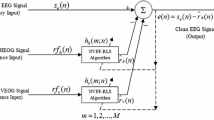Abstract
We recently proposed an adaptive filtering (AF) method for removing ocular artifacts from EEG recordings. The method employs two parameters: the forgetting factor λ and the filter length M. In this paper, we first show that when λ = M = 1, the adaptive filtering method becomes equivalent to the widely used time-domain regression method. The role of λ (when less than one) is to deal with the possible non-stationary relationship between the reference EOG and the EOG component in the EEG. To demonstrate the role of M, a simulation study is carried out that quantitatively evaluates the accuracy of the adaptive filtering method under different conditions and comparing with the accuracy of the regression method. The results show that when there is a shape difference or a misalignment between the reference EOG and the EOG artifact in the EEG, the adaptive filtering method can be more accurate in recovering the true EEG by using an M larger than one (e.g. M = 2 or 3).









Similar content being viewed by others
References
Croft RJ, Barry RJ (2000) Removal of ocular artifact from the EEG: a review. Neurophysiol Clin 30:5–19
Comstock JR, Arnegard RJ (1992) The multi-attribute task battery for human operator and strategic behavior research, NASA Technical Memorandum 104174
Erfanian A, Mahmoudi B (2005) Real-time ocular artifact suppression using recurrent neural network for electro-encephalogram based brain-computer interface. Med Biol Eng Comput 43:296–305
Gasser T, Sroka L, Möcks J (1985) The transfer of EOG activity into the EEG for eyes open and closed. Elecroencephalogr Clin Neurophysiol 61:181–193
Gratton G, Coles MGH, Donchin E (1983) A new method for off-line removal of ocular artifacts. Electroencephalogr Clin Neurophysiol 55:468–484
He P, Wilson G, Russell C (2004) Removal of ocular artifacts from electro-encephalogram by adaptive filtering. Med Biol Eng Comput 24:407–412
Jung TP, Makeig S, Westerfield M, Townsend J, Courchesne E, Sejnowski TJ (2000) Removal of eye activity artifacts from visual event-related potential in normal and clinical subjects. Clin Neurophysiol 111:1745–1758
Kenemans JL, Molenaar PCM, Verbaten MN, Slangen JL (1991) Removal of the ocular artifact from the EEG: a comparison of time and frequency domain methods with simulated and real data. Psychophysiology 28:115–121
Lagerlund TD, Sharbrough FW, Busacker NE (1997) Spatial filtering of multichannel electroencephalographic recordings through principal component analysis by singular value decomposition. J Clin Neurophysiol 14:73–82
Lins OG, Picton TW, Berg P, Scherg M (1993) Ocular artifacts in recording EEGs and even-related potentials: II. Source dipoles and source components. Brain Topogr 6:65–78
Quilter PM, MacGillivray BB, Wadbrook DG (1977) The removal of eye movement artifact from EEG signals using correlation techniques. Random signal analysis, IEEE Conference Publication 159:93–100
Shoker L, Sanei S, Wang W, Chambers JA (2005) Removal of eye blinking artifact from the electro-encephalogram, incorporating a new constrained blink source separation algorithm. Med Biol Eng Comput 43:290–295
Wallstrom GL, Kass RE, Miller A, Cohn JF, Fox NA (2004) Automatic correction of ocular artifacts in the EEG: a comparison of regression-based and component-based methods. Int J Psychophysiol 53:105–119
Whitton JL, Lue F, Moldofsky H (1978) A spectral method for removing eye movement artifacts from the EEG. Electroencephalogr Clin Neurophysiol 44:735–741
Widrow B, Glover JR, McCool JM, Kaunitz J, Williams CS, Hearn RH, Zeidler JR, Dong E, Goodlin RC (1975) Adaptive noise canceling: principles and applications. Proc IEEE 63:1692–1716
Woestenburg JC, Verbaten MN, Slanger JL (1983) The removal of the eye-movement artifact from the EEG by regression analysis in the frequency domain. Biol Psychol 16:127–147
Acknowledgments
This work was supported in part by the US Air Force Summer Fellowship Program.
Author information
Authors and Affiliations
Corresponding author
Appendix: The case of M = λ = 1 in adaptive filtering
Appendix: The case of M = λ = 1 in adaptive filtering
Let us consider a simplest case of the adaptive filtering method where M = λ = 1. In this case, Eq. (3) becomes:
The two filter coefficients, h v and h h , that minimize ε(n) can be obtained by solving the following two equations:
Equations (9) and (10) are identical to the two equations used by Quilter et al. [11] for removing EOG artifacts based on the least squares principal, albeit the variable notations were different. As a result, for the same set of the EEG and reference EOG data, the adaptive filtering method and the time-domain regression method produce exactly the same transmission coefficients. In this case, the only difference between the two methods is in implementation: while the TR method is applied once to the entire set of the collected data (the entire epoch), the AF method is implemented for sample-by-sample updating filter coefficients and removal of the EOG artifacts, starting from the beginning of data collection.
Rights and permissions
About this article
Cite this article
He, P., Wilson, G., Russell, C. et al. Removal of ocular artifacts from the EEG: a comparison between time-domain regression method and adaptive filtering method using simulated data. Med Bio Eng Comput 45, 495–503 (2007). https://doi.org/10.1007/s11517-007-0179-9
Received:
Accepted:
Published:
Issue Date:
DOI: https://doi.org/10.1007/s11517-007-0179-9




